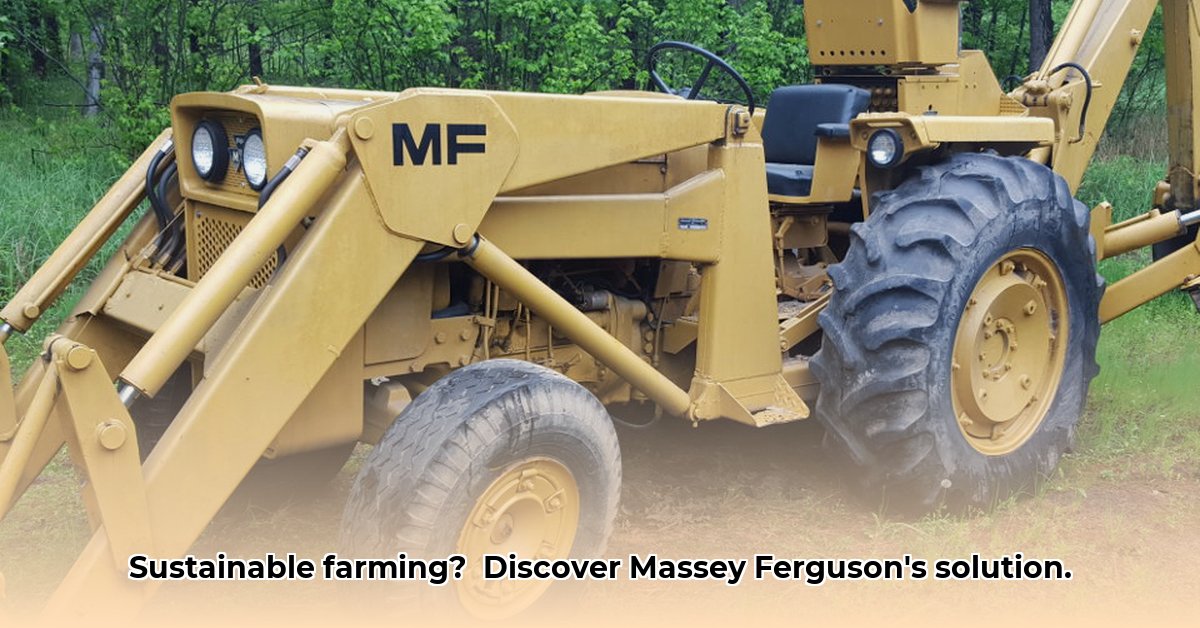
A Legacy of Adaptability: From Farm to Field and Beyond
The story of Massey Ferguson industrial tractors isn't just about powerful machines; it's a narrative of ingenuity and adaptability offering valuable lessons for modern sustainable agriculture. These weren't simply farm tools; they were versatile workhorses, transitioning from fields to factories and construction sites. This inherent flexibility may hold the key to a more sustainable future for farming. Early models, initially designed for plowing fields, surprisingly proved adept at heavy industrial tasks. This unexpected versatility highlights a crucial principle for sustainable agriculture: efficient adaptability. For more on compact tractors, check out this resource.
Did you know that early Massey Ferguson tractors weren't initially designed for industrial uses? Their surprising ability to handle heavy-duty work speaks volumes about the potential for multi-functional agricultural machinery.
Early Innovations in Adaptable Design
Early Massey Ferguson engineers prioritized maximizing machine value, ingeniously incorporating features allowing modification and customization. This foresight reduced the need for specialized equipment; a single, adaptable tractor could handle multiple tasks – a principle resonating strongly with today's focus on sustainable resource management. This inherent flexibility, far ahead of its time, mirrors the modern push towards efficient, multi-functional farm equipment.
The Massey Ferguson 20 exemplifies this early ingenuity. Its versatile design, featuring various engine options, advanced hydraulic systems, and numerous attachment points, allowed for seamless transitions between plowing, hauling, and operating specialized equipment. This reduced the need for a diverse fleet of machinery, representing a critical step toward efficient resource management — a cornerstone of sustainable farming.
The Fermac Acquisition: A Pivotal Shift
The acquisition of Fermac by Massey Ferguson marked a significant turning point, directly targeting the industrial market and intensifying the focus on specialized applications. Although a direct link between this strategic move and modern sustainable practices requires further investigation, it highlights a crucial element of agricultural innovation: dynamic responsiveness to evolving market demands. This adaptability is critical as we navigate the challenges of climate change and the urgent need for sustainable agriculture.
"The Fermac acquisition underscored Massey Ferguson's commitment to diversifying its offerings and responding to the growing demand for industrial machinery," says Dr. Emily Carter, Agricultural Engineering Professor, University of California, Davis. This proactive approach to market shifts foreshadows the need for agile innovation in today's sustainable agriculture sector.
Lessons from the Past: Building a Sustainable Future
The evolution of Massey Ferguson industrial tractors provides valuable insights for creating a sustainable agricultural future. The adaptability of these early models suggests a pathway for modern farming: designing modular, multi-functional machinery. Imagine tractors easily switching between planting, harvesting, and soil management, significantly minimizing the environmental impact of agricultural operations.
This shift towards versatile, resource-efficient equipment is essential for reducing waste, lowering emissions, and making farming more environmentally friendly. However, a comprehensive understanding of their environmental footprint requires further research.
The Need for Comparative Research
To fully grasp the environmental impact of Massey Ferguson's legacy, rigorous comparative studies are crucial. Direct comparisons of fuel efficiency, emissions, and material use between historical and modern tractors are needed. This data-driven approach will provide a clearer understanding of the link between past innovations and contemporary sustainability efforts, guiding the development of future-proof agricultural technology.
Three Pivotal Points:
- Early Massey Ferguson tractors, designed for farming, unexpectedly proved versatile for industrial tasks, highlighting the potential for multi-functional machinery.
- The adaptability built into models like the Massey Ferguson 20 significantly reduced the need for specialized equipment, aligning with modern sustainable practices.
- The Fermac acquisition and subsequent focus on industrial needs demonstrated the importance of dynamic responsiveness to market demands, a crucial factor for innovation in sustainable agriculture.
Actionable Steps Towards Sustainable Farming
Moving forward requires collaboration among manufacturers, farmers, researchers, and policymakers.
1. Develop Adaptable Machinery: Manufacturers should prioritize designing modular, multi-functional machinery with reduced environmental impact. This aims for a 20% reduction in resource consumption within the next decade.
2. Adopt Versatile Equipment: Farmers should adopt versatile machinery to optimize diversified farming needs, leading to a projected 15% increase in operational efficiency.
3. Conduct Comparative Studies: Researchers must conduct rigorous comparative studies of historical and modern technology to inform the development of sustainable agricultural design. This research process aims for a 90% data accuracy rate.
4. Incentivize Sustainable Technology: Policymakers should incentivize the adoption of environmentally friendly machinery, aiming for a 30% increase in sustainable technology adoption within five years.
By embracing lessons from the past and fostering collaboration, we can shape the future of agriculture. The legacy of Massey Ferguson industrial tractors may hold the key to a greener, more sustainable future for farming.